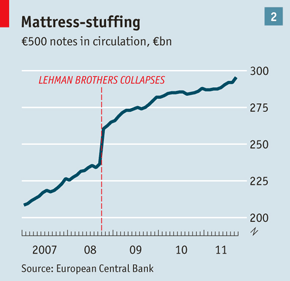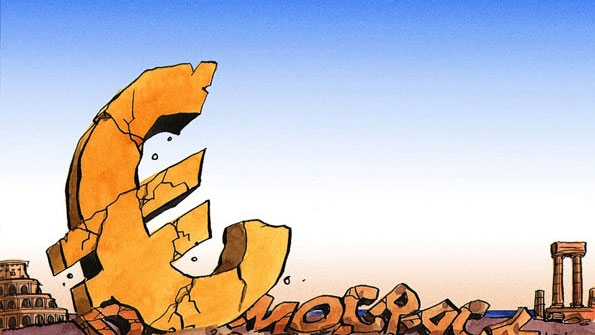November 13, 2011
Confidence in banking: the €500 supernote, or, we're all money launderers now
Chart of the day comes from the Economist:
Another sign of strain may be found in demand for €500 bills. These are too large for everyday transactions and are mainly used for mattress-stuffing or money laundering, say bankers. Demand for them surged after the collapse of Lehman Brothers in 2008, and it has ticked up again in recent months (see chart 2).
I don't know about you, but use of these unfortunate and economically nonsensical terms by bankers against their customers has always troubled me. Now however, I sense more than a slight cognitive dissonance with the suggestion that money launderers or mattress stuffers are surging.
During the Lehman Brothers Affair, the people lost a huge amount, possibly $150 billion.
The shockwave triggered all sorts of issues; one observer put it that, due to the response of banks like RBS to the crisis, the British ATM network was only hours from being shut down. And, that could have led within a day or to an outbreak of 'shopping with violence'.
In this sense, the people are not so much stuffing mattresses or money laundering, as unstuffing the bank's mattress or getting the money out before the financial system launders it down the tubes. The Lehmans uptick looks to be about 15bn, which looks pretty tame compared to the losses. Or if you take the financial community in Europe who potentially knew 1st hand about the meltdown, and divide by the size of the Lehman Brothers uptick, it's only a handful of supernotes for each aware banker...
To spell out what the Economist didn't put in words: we're looking at a run on the banks.
Even if we take it broader, by eyeball, the period of that chart shows an increase of 40% in demand for the supernote, from say 210 billion euros in 2007 to 295 now. Crudely put, we could imagine the initial starting value as a normal and stable state, and attribute any increase to a shift by the people into safer money stores.
40% is a pretty significant vote against the banks of Europe. Demand for the supernote might just be an inverse signal of confidence in banking.
In this sense, the euphemisms such as 'mattress stuffers' and 'money launderers/ backfire: although bankers in the past were keen to apply these terms to their cash-using customers, it now appears that the shoe is on the other foot. The bankers need to explain to the people in which mattress is the missing trillion euros, or whatever the final bill for Europe's financial meltdown ends up being.
Saving the euro requires more pain for some, more generosity from others and fundamental change for all. Is it worth it? Sooner or later, citizens must be asked. Without their support, no reform can last. And a real choice must include the option of leaving the euro. Now that this taboo has been breached, the euro zone should start thinking about how best to arrange the departure of those that cannot, or will not, live by Germanic rules.
Else, if this explanation isn't provided, and the money found, demand for supernotes is likely to increase as confidence in the banking system suffers from more 'strain', to use another euphemism. Or, in other words, we're all money launderers now, and the only question left is who runs fastest to who's fat mattress, the bankers or the people?
Either way, one to watch!
Posted by iang at November 13, 2011 06:26 AM | TrackBackHey Ian,
I'm not much of an economist, but looking at the source data at the ECB (http://www.ecb.int/stats/euro/circulation/html/index.en.html) and plotting value shares between "transactional money" (below 100€) and "mattress money" (above 100€) shows a fairly boring picture - the share of mattress money has even been falling recently. Total cash supply numbers aren't expanding crazily either... What do you make of that?
http://www.themel.com/ecb-cash.png is a painful 30 minutes' worth of dealing with OpenOffice calc & GIMP - I thought it would go faster than using R, but I was seriously wrong, and the output sucks badly.
Posted by: Thomas Themel at November 13, 2011 07:26 AMThomas,
You're right, your graph doesn't look anything like the Economist's!! Maybe there are two ECBs?
Posted by: Iang at November 13, 2011 09:40 AMWe're using the same source data, just graphing different things. When I looked at that Economist graph (absolute value of 500€ bills in circulation), I wondered why, excluding the Lehman discontinuity, there was a steady 12.5 bn/year increase even pre-crisis. This has apparently been going on since inception, and I still have no explanation for why it's there exactly, just general inflation/slowly ballooning money suppy?
Then I thought that the mattress stuffing hypothesis should stand out through a relative popularity increase in large notes over small ones, which doesn't seem to be there, see my graph. But as I said, I'm not an economist, so I'd love to hear from people who know more about this. A story that might work is that many of the people who had gotten 500 bills immediately post-Lehmann figured out over the last years that it's better to stuff the mattress with gold or CHFs instead of a fiat currency of questionable stability...
Posted by: Thomas Themel at November 13, 2011 11:24 AMthe congressional testimony into the pivotal role that rating agencies played in the whole thing had lots of the no-documentation, no-down, 1% interest only payment mortgages going to speculators (2000% ROI in parts of country with 20-30% inflation during the bubble) ... but also a large number going for drug cartel money laundering.
On the real-estate side of the operation, the mostly unregulated loan originators being able to pay for triple-A ratings on the packaged mortgages (toxic CDOs), met they no longer had to care about the borrower's qualifications or mortgage quality ... contributing to no-documentation loans. On the wallstreet side of the operation they were taking enormous cut, fees & commissions on the estimated $27T in triple-A rated toxic CDOs done during the bubble.
Wallstreet used the off-book of the too-big-to-fail as dumping ground for huge amounts of the triple-A toxic CDOs as dumping ground (end of 2008, $5.2T in triple-A toxic CDOs being held off-balance by just the four too-bit-to-fail
Posted by: Lynn Wheeler at November 13, 2011 11:26 AMSince the onset of the financial crisis in summer 2007 there has been stronger growth in demand for £50s, pointing to an increase in demand for banknotes as a store of value.
...
3.3.7 Economic conditions
The changed economic conditions since the start of the financial crisis in August 2007 have probably impacted the circulation of cash in a number of ways, most of which will have stimulated the use of cash:
* grey economy: possibly the largest but most difficult to quantify is the extent to which, faced with harder economic times, people or businesses prefer to receive cash for goods or services where the subsequent accounting for VAT or other tax can be less rigorous than previously. The velocity of circulation of £20s has dropped recently, indicating that they are spending more time outside the known channels of cash circulation, or being hoarded;
* store of state-backed value: there is evidence from the Bank of England’s data on notes in circulation that some increased demand for £50s has been from customers using the notes as a store of value;
* budgeting: many people do find that, faced with budgetary pressure, it is easier to budget with cash: a week’s cash can be withdrawn, and during the week can easily be counted and compared with the amount of the week remaining. This would impact most denominations of notes, and all coin. However, there are some who find it easier to budget with cards, as the precise amount for a transaction is paid: these cardholders find that cash change is too easily spent.

